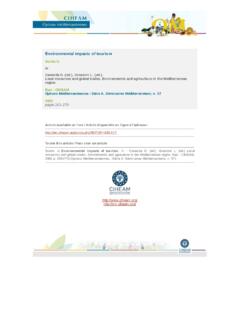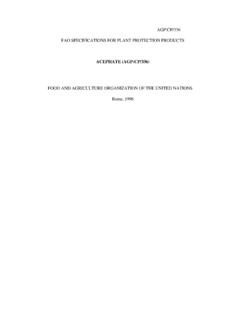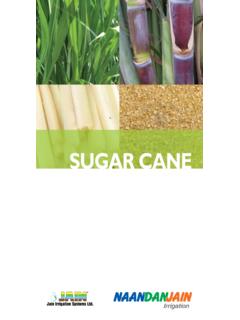Transcription of Advantages and disadvantages of land use …
1 Advantages and disadvantages of land use changes for the preservation of soil resources. Review of soil conservation practices and the need for related research Giordano A., Filippi N. Etat de l'Agriculture en M diterran e. Les sols dans la r gion m diterran enne : utilisation, gestion et perspectives d' volution Zaragoza : CIHEAM. Cahiers Options M diterran ennes; n. 1(2). 1993. pages 113-134. Article available on lin e / Article dispon ible en lign e l'adresse : ---------------------------------------- ---------------------------------------- ---------------------------------------- ---------------------------------------- ---------- ---------------------------------------- ---------------------------------------- ---------------------------------------- ---------------------------------------- ---------- To cite th is article / Pou r citer cet article ---------------------------------------- ---------------------------------------- ---------------------------------------- ---------------------------------------- ---------- Giordano A.
2 , Filippi N. Advan tages an d disadvan tages of lan d u se ch an ges for th e preservation of soil resou rces. Review of soil con servation practices an d th e n eed for related research . Etat de l'Agriculture en M diterran e. Les sols dans la r gion m diterran enne : utilisation, gestion et perspectives d' volution . Zaragoza : CIHEAM, 1993. p. 113-134 (Cahiers Options M diterran ennes; n. 1(2)). ---------------------------------------- ---------------------------------------- ---------------------------------------- ---------------------------------------- ---------- CIHEAM - Options Mediterraneennes Advantages and disadvantages of land use changes for the preservation of soil resources. Review of soil conservation practices and the need for related research A. GIORDANO. TORINO. ITALY. N. FlLlPPI. REGIONE EMILIA-ROMAGNA. CARTOGRAPHY SERVICE. BOLOGNA. ITALY. SUMMARY - Theintensiveandfrequentlandusechanges in theMediterraneancountrieshave numerous and negative environmental impacts.
3 In order to asses land degradation, several models and cartographies have been prepared: Glasod, Corine, Italian Ministery of Environment and UNEP. The future EC policies for agriculture and related soil conservation aspects must be oriented by these documents as well as by the state of art of the main soil conservation practices. Needs for future research are concerned with the following fields:1) Economical analyses of soil conservation practices;. 2) Remote sensing for detecting land degradation; 3) Natural resources survey based on land and land useunits; 4) Constitutionofbenchmarksoils;and 5) Correlationofsimilarlanduse in different countries. Key words: land use changes, land degradation, soil erosion, environmental impact assessment, landscape protection. RESUME - Les changements intensifset fr quents de l'utilisation du sol dans les pays m diterran ens causent de nombreux impacts n gatifs sur l'environnement.
4 Afin d' valuer la d gradation du sol, plusieursmod les et cartographiesont t pr par s : Glasod,Corine,Minist reItaliende l'Environnement et UNEP. Les futures politiques de la CE pour l'agriculture et les aspects en relation avec la conservation du sol, doivent tre orient es suivant ces documents, ainsi que les connaissances actuelles des principales pratiques de conservation du sol, La recherche future a besoin d' tudes dans les domaines suivants :1) Analyse conomique des pratiques de conservation du;2) solT l d tection pour d tecter la d gradation dusol ;3) Etude des ressources naturelles bas es sur le solet sur les unit s d'utilisation du sol ;4) Etablissement de sols types;et 5) Corr lation entre les utilisations du sol semblables dans diff rents pays. Mots-cl s: Changements d'utilisation dusol, d gradation dusol, erosion du sol, evaluation de l'impact sur l'environnement, protection du paysage.
5 As pointed outby OECD (1 991) there aretwo main features deeply affecting the modern agriculture 113. CIHEAM - Options Mediterraneennes and its consequent changes: i. The trend towards increasing vertical integration of the food sector. i .The growing imbalance between agricultural production and the demand for outputs. Following the vertical integration the farmers have only a limited degree of choice since they depend almost on the external market which is well-known to be subject to frequent changes. The second feature outlines the tendency for agricultural production to overcome the real consumers demand. Since both of these trends can be expected to continue in the they provide the background for new changes in land use which not only will affect agriculture but also the environment and the landscape ecology. It is clearlyimportant to analyzethesechangesandtheirenvironmental effects,for re-orientating land planning and regional agricultural policy.
6 LandusechangesintheMediterraneancountrie spositiveand/ornegative consequences in relation to thesoil resource Agricultural land use changes During the and thefocusonincreasingsoilproductivityhas led to intensification of agriculture which has been followed by numerous environmental impacts and namely: i. Increasedsoildegradation,especiallyerosi on. i . Increased transfer of residual substances from farmland to surface water and groundwater. iii. Increased presence of extraneous matter in foodstuffs. v. Disappearance of certain types of rural landscape and habitat. From up to the consequences of the new agricultural policies have intensively marked the land use in the OECD countries. Table shows that the agricultural areas have increased in the world, they have decreasedin USA, Japan and Europe, with few exceptions (France, Holland, Greece, NorwayandSwitzerland).According to FAO thearea ofcultivatedland in European Mediterranean countries has fallen by ha in the period (equal to per cent of total agricultural land ).
7 A summary prepared by Giordano (1 on the agricultural land use changes which occurred in the Mediterranean countries, deals with the following 3 points: a)Farminghasbecomebothmoreintensiveandmo rehighlymechanised,particulary in more favourable agricultural a consequence, monoculture systems have tendedto spread into hill areas where traditionally crop rotations and crop sequences were carried out. They also to tend concentrate onthe plains, with a consequent reduction on the hills and mountains of pastures; grass crops, in the lowlands-contrary to whatmight be thought- contraction of forage crops has also occurred, due to the increasing use of food-concentrates by livestock breeders, accordingto Giau (1 In addition, there has been a progressive depopulation of the countryside, especiallyin more remote areas, as the decline of share-cropping has seen the emergence of forms of land management characterised by larger farms and fewer farmhands.)
8 B) At the same time, far-reaching developments in agricultural practices and technology have occurred. Farmmechanisationandintensificationhave led to anumberofsignificantchanges in field management, including: 114. CIHEAM - Options Mediterraneennes Table in theperiod (OECD, land area Arable and crop land T- Wooded areas Area Area Change Area Change km2 km2 (%) ( W km2 ( h) ( 4. Canada - USA. Japan Australia New Zealand Austria Belgium Denmark Finland France Greece Ireland Italy Netherlands Norway Portugal Spain Sweden Switzerland 10. Turkey UK. Yugoslavia OECD. World , 1 The following definitions (FAO classification) have been used: - Arable land refers toland under temporary crops, temporary meadows for mowing or pasture, land under market and kitchen gardens (including cultivation under glass), and land temporarily fallow or lying idle. - Permanent crop land refers to land cultivated with crops that occupy the land for long periods and need not to be replanted after each harvest, such as cocoa, coffee and rubber; it includes land under shrubs, fruit trees, nut trees and vines, but excludes land under trees grown for wood timber.))
9 - Wooded areas refer to land under coniferous, non-coniferous and mixed forest as well as other wooded land accordingto FAO specifications. CIHEAM - Options Mediterraneennes - The removal of hedgerows, ditches,,dry stone walls and tree line. - The creation of larger fields. - Field-levelling. - Increased frequency of tillage. - Cultivation of steeper slopes (often involving up-and-down ploughing). - Increased irrigated areas (Table 2). c) Traditional terrace systems have also been abandoned on steep slopes, while top-benching is frequently practised hilly and mountainous regions,thus-completelyaltering both the landscape and local hydrology. The decline of pastoralism, and reduction in livestock numbers, are likewise affecting soil conditions by reducing the returns of manure to fields, and by substituting forage crops and permanent pastures with annual crops, which provide less complete soil cover less effective and protection against erosion.
10 Together, these changes are undoubtedly affecting soil fertility, and/or be encouraging soil degradation in many areas of the Mediterranean region. The above illustrated changes in agricultural land use have a number of impacts on the environment - (Table 3). Table 2. Trends in irrigatedareas (OECD, 1991). -r Agricultural land Irrigated areas 1 km' % Change km' % Change -1. Canada USA. Japan -1. France Germany (a) 119. Italy Netherlands Spain UK '. North America OECD Pacific OECD Europe OECD .l World (a) Includes Western Germany only 116. CIHEAM - Options Mediterraneennes Table 3. Agriculturalpracticesandimpacts on thesoil (FAO-UNESCO,1980). Agricultural practices Impact on soil Impact on other physical resources land management Soil degradation Loss of biodiversity Loss of habitats Irrigation and drainage Salinization land degradation Waterlogging Tillage Reduced soil porosity Structural degradation Mechanisation Physical soil degradation Fertiliser application Nitrogen Nitrate leaching Phosphate Accumulation of heavy metals Effects on soil microfauna Direct discharges leadingto eutrophication Manure slurry Accumulation of phosphates Residues in drainage water Excessive copper (pig slurry).







